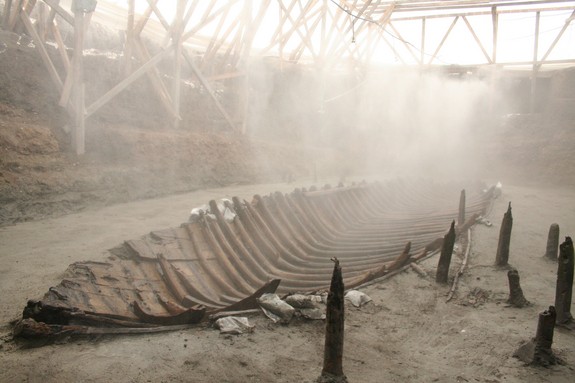Byzantine Shipwrecks Help to Understand Shipbuilding History
| Marco Foronda | | Dec 29, 2014 05:45 AM EST |
(Photo : Institute of Nautical Archaeology at Texas A&M University /M. Jones) The Yenikapı shipwreck called YK 14 was a 9th-century merchant ship.
Archaeologists are now examining the remains of 37 shipwrecks that could shed light on the history of shipbuilding.
Live Science said the wrecks reveal how ship-building evolved during the Middle Ages.
The researchers discovered the shipwrecks in Yenikapi, a port in Istanbul. They said the wrecks are still in good shape and that these date from the 5th and 11th centuries.
Like Us on Facebook
"Never before has such a large number and types of well-preserved vessels been found at a single location," said study author Cemal Pulak, of the Institute of Nautical Archaeology at Texas A&M University.
Archaeologists found six round ships, 26 to 48 feet long, and propelled mostly by sail. They also found two oared galleys 100 feet long.
In some of these ships, the shell was constructed first while others had the skeleton built first. So the shell-first to skeleton-first transition was already underway by the seventh century, researchers say.
"It is through meticulous and time-consuming detective work that we slowly begin to understand how these ships were built, modified, overhauled and used. By such means, we try understand the minds of the shipbuilders and their design and conceptualization processes, in order to better comprehend the history of science and engineering," Pulak said.
According to Institute of Nautical Archaeology, the site has produced leather shoes, wooden combs, horses, camels, and human heads that may have belonged to criminals whose skulls were thrown in the harbor.
A large museum in Istanbul is planning to exhibit many of the wrecks. But Pulak said it could take several years to restore the timber of each ship's hull, he said.
The report of the discovery was published online in the International Journal of Nautical Archeology.
TagsByzantine Shipwrecks, ancient ship, shipbuilding, wrecks, ancient artifact, artifact
©2015 Chinatopix All rights reserved. Do not reproduce without permission
EDITOR'S PICKS
-

Did the Trump administration just announce plans for a trade war with ‘hostile’ China and Russia?
-

US Senate passes Taiwan travel bill slammed by China
-

As Yan Sihong’s family grieves, here are other Chinese students who went missing abroad. Some have never been found
-

Beijing blasts Western critics who ‘smear China’ with the term sharp power
-

China Envoy Seeks to Defuse Tensions With U.S. as a Trade War Brews
-

Singapore's Deputy PM Provides Bitcoin Vote of Confidence Amid China's Blanket Bans
-

China warns investors over risks in overseas virtual currency trading
-

Chinese government most trustworthy: survey
-

Kashima Antlers On Course For Back-To-Back Titles
MOST POPULAR
LATEST NEWS
Zhou Yongkang: China's Former Security Chief Sentenced to Life in Prison

China's former Chief of the Ministry of Public Security, Zhou Yongkang, has been given a life sentence after he was found guilty of abusing his office, bribery and deliberately ... Full Article
TRENDING STORY

China Pork Prices Expected to Stabilize As The Supplies Recover

Elephone P9000 Smartphone is now on Sale on Amazon India

There's a Big Chance Cliffhangers Won't Still Be Resolved When Grey's Anatomy Season 13 Returns

Supreme Court Ruled on Samsung vs Apple Dispute for Patent Infringement

Microsoft Surface Pro 5 Rumors and Release Date: What is the Latest?










